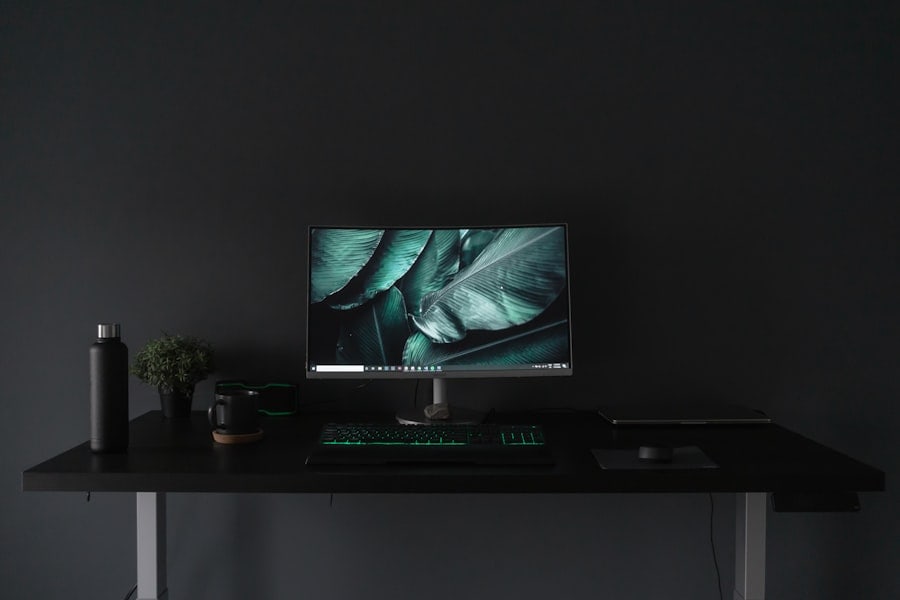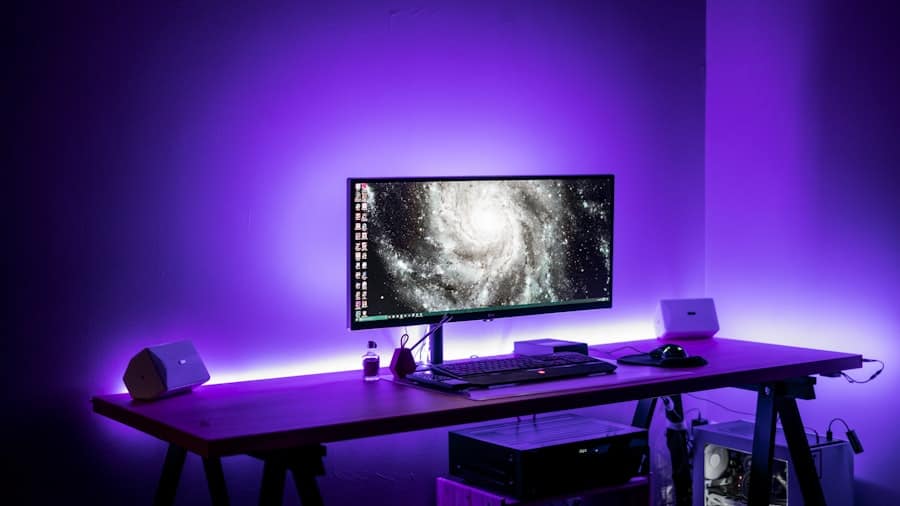The integration of artificial intelligence (AI) into high-end personal computers marks a significant evolution in the realm of computing technology. As users demand more from their machines, the capabilities of AI have expanded to meet these needs, transforming how we interact with our devices. High-end PCs, once primarily defined by their raw processing power and graphics capabilities, are now increasingly characterized by their intelligent features that enhance performance, efficiency, and user experience.
This shift is not merely a trend; it represents a fundamental change in the architecture of computing systems, where AI plays a pivotal role in optimizing various functions. The advent of AI in high-end PCs has opened up new avenues for innovation, allowing manufacturers to create systems that are not only powerful but also smart. These machines can learn from user behavior, adapt to specific tasks, and even predict future needs.
As a result, users can expect a more seamless and intuitive experience, whether they are gaming, designing graphics, or performing complex computations. The marriage of AI with high-performance computing is setting the stage for a new era where machines are not just tools but intelligent partners in productivity and creativity.
Key Takeaways
- AI is revolutionizing high-end PCs by enhancing graphics, visuals, system optimization, cooling, power management, real-time response, predictive maintenance, and personalization.
- AI-powered graphics and visuals are improving image quality, resolution, and frame rates, providing a more immersive gaming and multimedia experience.
- AI-driven system optimization is maximizing performance by dynamically adjusting settings based on usage patterns and workload demands.
- AI-assisted cooling and power management are maintaining optimal temperatures and power consumption for peak performance and efficiency.
- AI-enabled real-time response and control are enhancing user experience by quickly adapting to changing tasks and demands, providing a seamless and responsive computing experience.
AI-Powered Graphics and Visuals
One of the most striking applications of AI in high-end PCs is its impact on graphics and visuals. Traditional graphics processing units (GPUs) have long been the backbone of visual rendering, but AI is now enhancing this process in remarkable ways. Through techniques such as deep learning and neural networks, AI can analyze vast amounts of visual data to improve image quality, rendering speed, and overall graphical fidelity.
This capability is particularly beneficial in gaming and professional design applications, where visual realism is paramount. For instance, AI algorithms can upscale lower-resolution images to higher resolutions without the typical loss of quality associated with traditional upscaling methods. This process, known as super-resolution, allows gamers to enjoy visually stunning environments even on hardware that may not be cutting-edge.
Additionally, AI can assist in real-time rendering by predicting which elements of a scene will require more processing power based on user interactions. This predictive capability ensures smoother frame rates and more immersive experiences, making high-end PCs not just faster but also smarter in how they handle graphics.
AI-Driven System Optimization
Beyond graphics, AI is revolutionizing system optimization in high-end PCs. The traditional approach to system performance often involved manual adjustments and configurations by users or reliance on basic software tools. However, with AI-driven optimization, systems can now autonomously analyze their performance metrics and make real-time adjustments to enhance efficiency.
This includes optimizing CPU and GPU usage based on current workloads, managing memory allocation more effectively, and even adjusting power settings to balance performance with energy consumption. Moreover, AI can learn from user habits over time, identifying patterns that allow it to preemptively allocate resources where they are most needed. For example, if a user frequently switches between demanding applications like video editing software and resource-intensive games, the system can adjust its settings accordingly to ensure optimal performance during these transitions.
This level of intelligent resource management not only improves the user experience but also extends the lifespan of hardware components by reducing unnecessary strain.
AI-Assisted Cooling and Power Management
As high-end PCs push the boundaries of performance, effective cooling and power management become critical concerns. Excessive heat can lead to thermal throttling, where components reduce their performance to avoid overheating. AI-assisted cooling systems address this issue by intelligently monitoring temperature levels and adjusting fan speeds or cooling mechanisms in real-time.
By analyzing data from various sensors within the system, AI can determine the most efficient cooling strategy based on current workloads and environmental conditions. In addition to cooling, AI plays a vital role in power management. High-performance components often consume significant amounts of energy, leading to increased operational costs and environmental impact.
AI algorithms can optimize power consumption by dynamically adjusting voltage and frequency based on workload demands. This not only enhances energy efficiency but also contributes to a quieter computing experience as fans operate at lower speeds when full power is not required. The result is a more sustainable approach to high-performance computing that aligns with modern environmental considerations.
AI-Enabled Real-Time Response and Control
The ability of high-end PCs to respond in real-time to user inputs and environmental changes is greatly enhanced by AI technologies. With advancements in machine learning and natural language processing, these systems can now interpret user commands more accurately and execute tasks with remarkable speed. For instance, voice-activated assistants powered by AI can manage system settings, launch applications, or even perform complex tasks based on simple verbal instructions.
Furthermore, AI-enabled systems can adapt their responses based on context. If a user is engaged in a gaming session and suddenly receives a notification for an important task, the system can prioritize resources accordingly without disrupting the gaming experience. This level of intelligent control allows users to maintain focus on their primary activities while still being responsive to other needs.
The seamless integration of real-time response capabilities into high-end PCs exemplifies how AI is enhancing user interaction with technology.
AI-Based Predictive Maintenance
Predictive maintenance is another area where AI is making significant strides in high-end PC performance. Traditionally, users would rely on periodic maintenance checks or troubleshooting when issues arose. However, with AI’s ability to analyze system data continuously, it can predict potential failures before they occur.
By monitoring hardware performance metrics such as temperature fluctuations, power consumption patterns, and component wear levels, AI can alert users to potential problems well in advance. This proactive approach not only minimizes downtime but also saves users from costly repairs or replacements. For example, if an AI system detects that a hard drive is showing signs of failure based on its read/write patterns or temperature spikes, it can notify the user to back up data and consider replacing the drive before it fails completely.
This shift from reactive to predictive maintenance represents a significant advancement in how users manage their high-end PCs, ensuring that systems remain reliable and efficient over time.
AI-Infused Personalization and User Experience
Personalization has become a key focus in technology development, and high-end PCs are no exception. AI-infused personalization allows these systems to tailor experiences based on individual user preferences and behaviors. By analyzing usage patterns, AI can recommend software applications, optimize settings for specific tasks, or even adjust interface layouts to suit user habits better.
This level of customization enhances productivity and makes interactions with technology more intuitive. Moreover, personalization extends beyond mere recommendations; it encompasses the entire user experience. For instance, an AI system might learn that a user prefers dark mode for their applications during nighttime use or that they frequently switch between multiple monitors for multitasking purposes.
By adapting to these preferences automatically, the system creates a more comfortable and efficient working environment. As users increasingly seek technology that understands their needs, the role of AI in delivering personalized experiences will only grow more prominent.
The Future of AI in High-End PC Performance
The future of high-end PCs is undeniably intertwined with the advancements in artificial intelligence. As technology continues to evolve at an unprecedented pace, the capabilities of AI will expand further, unlocking new possibilities for performance enhancement and user interaction. From optimizing graphics rendering to enabling predictive maintenance and personalized experiences, AI is set to redefine what users can expect from their computing devices.
As we look ahead, it is clear that the integration of AI into high-end PCs will not only improve performance but also foster a deeper connection between users and their machines. The potential for smarter systems that learn and adapt will lead to more efficient workflows and enhanced creativity across various fields. Ultimately, the future of high-end PC performance lies in harnessing the power of artificial intelligence to create machines that are not just powerful but also intelligent companions in our digital lives.
If you are interested in how technology is enhancing connectivity, you may want to check out this article on how smartwatches are revolutionizing the way we stay connected. Just like AI is improving real-time performance in high-end PCs, smartwatches are changing the way we interact with our devices and the world around us. Both technologies are pushing the boundaries of what is possible in the digital age.
FAQs
What is AI?
AI stands for artificial intelligence, which refers to the simulation of human intelligence processes by machines, especially computer systems.
How does AI enhance real-time performance in high-end PCs?
AI enhances real-time performance in high-end PCs by optimizing system resources, predicting user behavior, and automating tasks to improve overall efficiency and speed.
What are some examples of AI technologies used in high-end PCs?
Some examples of AI technologies used in high-end PCs include machine learning algorithms for predictive analysis, natural language processing for voice commands, and computer vision for image recognition.
What are the benefits of AI-enhanced real-time performance in high-end PCs?
The benefits of AI-enhanced real-time performance in high-end PCs include faster processing speeds, improved multitasking capabilities, enhanced security features, and personalized user experiences.
Are there any potential drawbacks or limitations to AI-enhanced real-time performance in high-end PCs?
Some potential drawbacks or limitations to AI-enhanced real-time performance in high-end PCs include increased energy consumption, privacy concerns related to data collection, and the potential for AI bias in decision-making processes.



